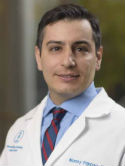Technical feasibility of salvage endoscopic submucosal dissection after chemoradiation for locally advanced rectal adenocarcinoma Journal Article
| Authors: | Leung, G.; Nishimura, M.; Hingorani, N.; Lin, I. H.; Weiser, M. R.; Garcia-Aguilar, J.; Pappou, E. P.; Paty, P. B.; Schattner, M. A. |
| Article Title: | Technical feasibility of salvage endoscopic submucosal dissection after chemoradiation for locally advanced rectal adenocarcinoma |
| Abstract: | Background and Aims: The standard treatment of locally advanced rectal cancer is chemoradiation (CRT) followed by proctectomy and adjuvant chemotherapy. However, there is an emerging role for nonsurgical management after CRT or total neoadjuvant therapy (TNT) consisting of CRT and neoadjuvant chemotherapy. Endoscopic submucosal dissection (ESD) after CRT or TNT for rectal cancer, termed “salvage ESD,” may be a viable nonsurgical option for carefully selected patients. We aimed to evaluate the feasibility and safety of salvage ESD. Methods: A retrospective chart review of cases of salvage ESD for locally advanced rectal cancer and standard ESD for rectal tumors without prior CRT from July 2018 to August 2020 at our institution was performed. Clinical factors and imaging, procedural, and pathology results were collected and compared. Results: Twelve salvage ESD cases were compared with 27 standard ESD cases. Before CRT, 83.3% of lesions in the salvage ESD group were initially clinically staged as T3. The en-bloc resection rates were 92.7% and 91.7% (P = 1.00) and R0 resection rates 66.7% and 75.0% (P = .55) for the standard and salvage groups, respectively. In the salvage ESD group, no adverse events were observed, and 75.0% of the adenocarcinomas in the salvage ESD group had morphologically changed to hyperplasia or adenoma after CRT, with no identifiable lesions greater than T1 tumor depth. Conclusions: Salvage ESD for locally advanced rectal cancer is technically feasible with low adverse event rates. There may be a diagnostic role in salvage ESD in assessing pathologic response to CRT and a possible therapeutic role in resection of residual lesions with the potential to avoid surgery. © 2022 American Society for Gastrointestinal Endoscopy |
| Keywords: | adult; clinical article; treatment outcome; middle aged; retrospective studies; salvage therapy; bevacizumab; fluorouracil; advanced cancer; cancer combination chemotherapy; capecitabine; adenocarcinoma; pathology; medical record review; retrospective study; feasibility study; adverse outcome; adenoma; feasibility studies; folinic acid; hyperplasia; oxaliplatin; postoperative hemorrhage; rectal neoplasms; rectum tumor; chemoradiotherapy; adenomatous polyp; rectum adenoma; en bloc resection; rectal adenocarcinoma; endoscopic mucosal resection; procedures; clinician; endoscopic submucosal dissection; tubulovillous adenoma; humans; human; male; female; article; tumor depth |
| Journal Title: | Gastrointestinal Endoscopy |
| Volume: | 96 |
| Issue: | 2 |
| ISSN: | 0016-5107 |
| Publisher: | Mosby Elsevier |
| Date Published: | 2022-08-01 |
| Start Page: | 359 |
| End Page: | 367 |
| Language: | English |
| DOI: | 10.1016/j.gie.2022.02.014 |
| PUBMED: | 35183541 |
| PROVIDER: | scopus |
| DOI/URL: | |
| Notes: | Article -- Erratum issued, see DOI: 10.1016/j.gie.2023.11.010 -- Export Date: 13 January 2023 -- Source: Scopus |
Altmetric
Citation Impact
BMJ Impact Analytics
MSK Authors
Related MSK Work










